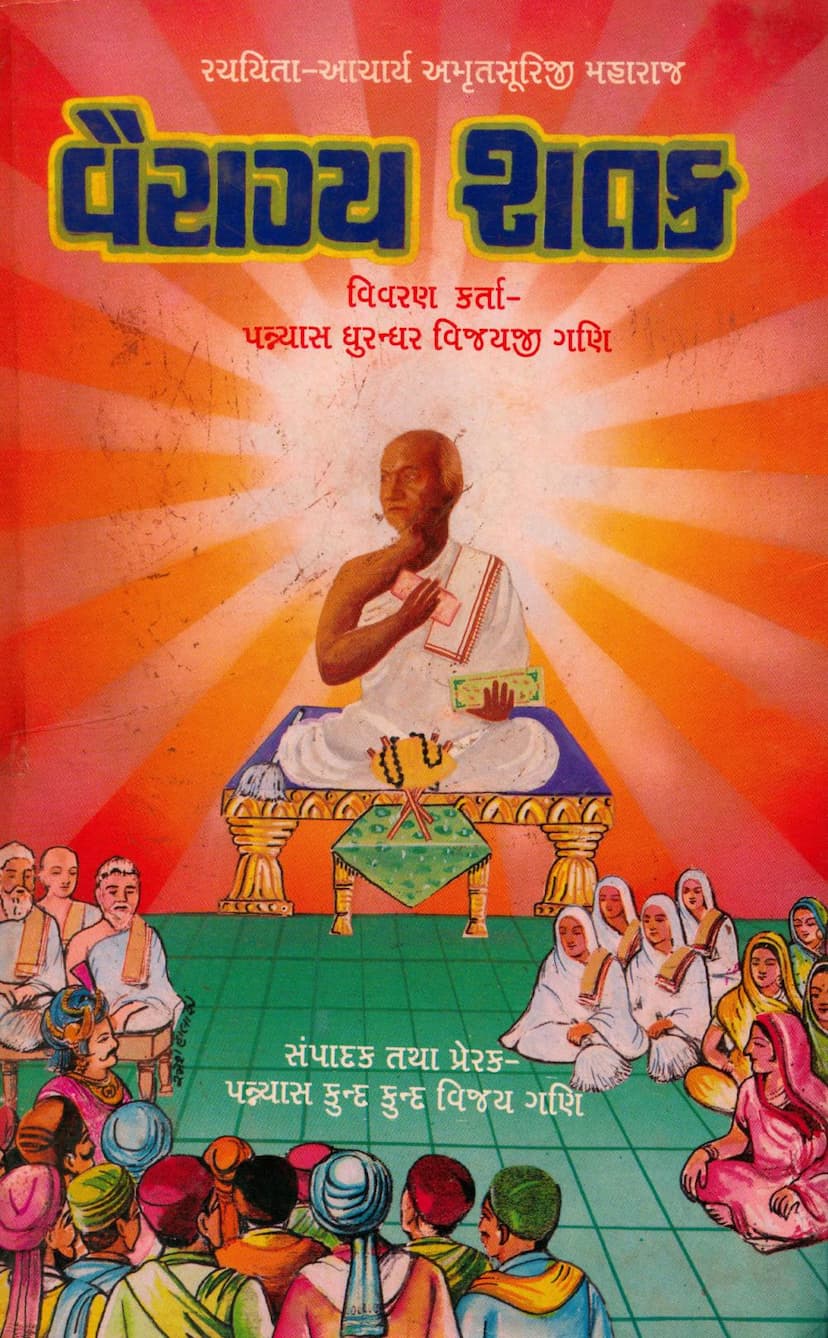Vairagya Shatak
Added to library: September 2, 2025

Summary
Here's a comprehensive summary of the Jain text "Vairagya Shatak," based on the provided pages:
Book Title: Vairagya Shatak Authors: Acharya Amrut Suri, Dhurandhar Vijay Gani, Kundakund Vijay Gani (as editor/inspirer) Publisher: Shri Dhurandhar Suri Samadhi Mandir, Ahmedabad Catalog Link: https://jainqq.org/explore/022142/1
Overall Summary:
"Vairagya Shatak" (The Hundred Verses on Dispassion) is a significant Jain text focused on cultivating detachment (vairagya) from worldly attachments and guiding the soul towards liberation. The book is presented as a compilation of profound teachings that inspire spiritual aspiration, characterized by its clear language and impactful verses.
Key Components and Themes:
-
Praise and Reverence: The book begins with auspicious beginnings and praises to Jain Tirthankaras and spiritual gurus. Specifically, it includes Stuti Chaturvinsatika (Praise of the Twenty-Four Tirthankaras) at the beginning, composed by Acharya Vijayamrut Suri. These verses are designed to evoke devotion, elevate the spirit, and unite the devotee with the divine. The author emphasizes their ease of memorization and the uplifting effect they have on the reader.
-
"Vairagya Shatak" - The Core Teaching: The central part of the book is the "Vairagya Shatak" itself, which consists of 100 verses in Gujarati composed by Acharya Vijayamrut Suri during his ascetic life. These verses are described as a means to attain the "knowledge path" of spiritual liberation. The verses systematically present profound truths that guide the soul to realize its true nature and detachment from the cycle of rebirth.
-
Key Topics Covered in "Vairagya Shatak": The text elaborates on eight main themes:
- The rarity and preciousness of human birth.
- Descriptions of the sufferings in hellish realms.
- Inspiration to renounce attachment to women.
- The nature of the sixteen reflections (Shodash Bhavna).
- The impermanence and insubstantiality of the world.
- The disadvantages and losses incurred from engaging with the senses and their objects.
- Urgency to practice Dharma promptly.
- Beneficial and guiding reflections for spiritual progress. The verses are praised for their straightforward and potent language, aiming to naturally instill dispassion towards the material world.
-
"Atmanindadwātrinśika" - Self-Condemnation: Following the "Vairagya Shatak," the book includes a Gujarati translation of the "Atmanindadwātrinśika" (Thirty-Two Verses of Self-Condemnation) by Paramarhat Kumar Pal. This section addresses the soul directly, vividly portraying its dependent and vulnerable state, encouraging self-reflection and repentance. These verses are also highlighted for their depth and the desire they create for repeated reading and contemplation, leading to spiritual upliftment.
-
Source and Authenticity: The text explicitly states that its content is not fabricated but is drawn and compiled from ancient Jain scriptures and the teachings of revered Tirthankaras and Āchāryas. This emphasizes the authoritative and authentic nature of the presented wisdom.
-
Purpose and Impact: The ultimate aim of "Vairagya Shatak" is to foster dispassion, guide individuals towards true happiness, and help them escape suffering. The compiler and inspiring editor, Pandit Kundakund Vijay Gani, emphasizes that the dedication and effort in publishing this book will be fruitful if even a single soul attains dispassion and walks the path of true happiness.
-
Structure and Presentation:
- The book is presented in Gujarati.
- It includes the original verses by Acharya Vijayamrut Suri and commentary/explanation by Acharya Dharmandhar Suri.
- Pandit Kundakund Vijay Gani serves as the editor and motivator for this publication.
- The preface and introductory sections provide context, explain the significance of the text, and highlight the contributions of the gurus.
- The text also includes a list of donors and supporters, indicating the community effort behind its publication.
Key Gurus Mentioned:
- Acharya Vijayamrut Suri: The primary author of the "Vairagya Shatak" verses. He is described as the crown-jewel of Acharya Vijay Nemisurishwarji, a gem of poets, and a master of scriptures.
- Acharya Dharmandhar Suri: The commentator whose explanations enhance the understanding of the verses. He composed the commentary during his monastic life.
- Acharya Vijay Nemisurishwarji: The revered guru of Acharya Vijayamrut Suri, referred to as the "Emperor of the Regime."
- Pandit Kundakund Vijay Gani: The editor and inspirer of this particular edition, known for promoting knowledge and devotion.
Underlying Philosophy:
The text strongly advocates for Vairagya (dispassion/detachment) as a fundamental prerequisite for spiritual progress and liberation. It highlights the impermanence of worldly possessions, relationships, and even life itself, urging readers to detach from these fleeting experiences. The path of detachment is presented as essential for achieving true, lasting happiness and escaping the miseries of the cycle of birth and death (samsara). The book also underscores the importance of Gyan Marg (path of knowledge) and Bhakti Marg (path of devotion), emphasizing the latter's accessibility to all.
In essence, "Vairagya Shatak" is a comprehensive spiritual guide that uses evocative language and teachings to inspire introspection, detachment, and a sincere pursuit of liberation in the Jain tradition.